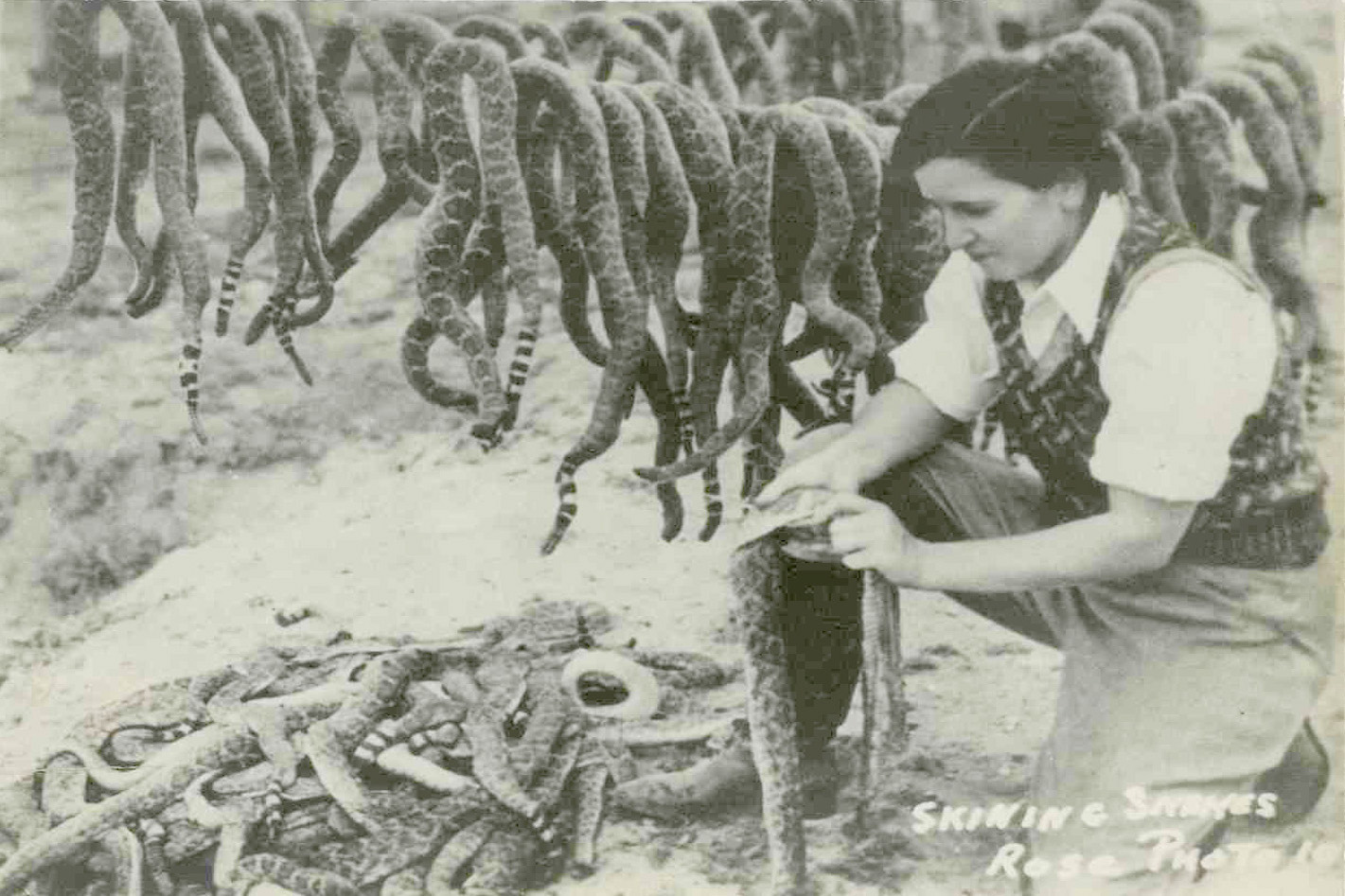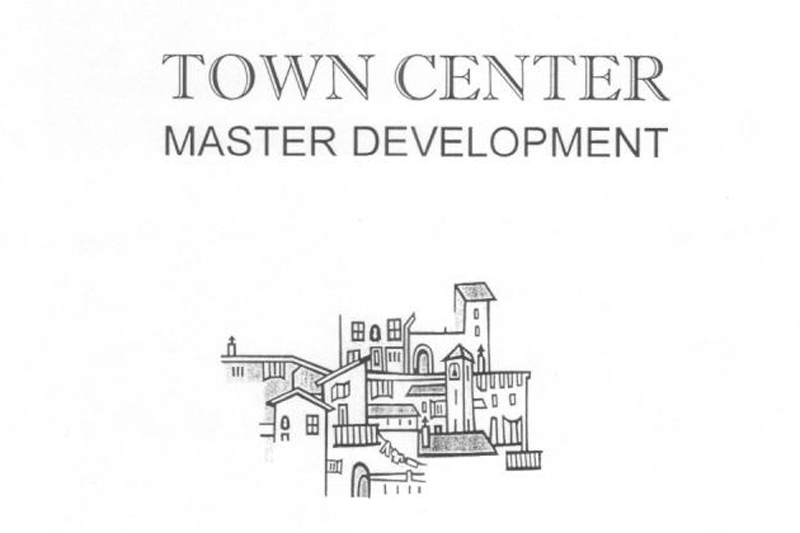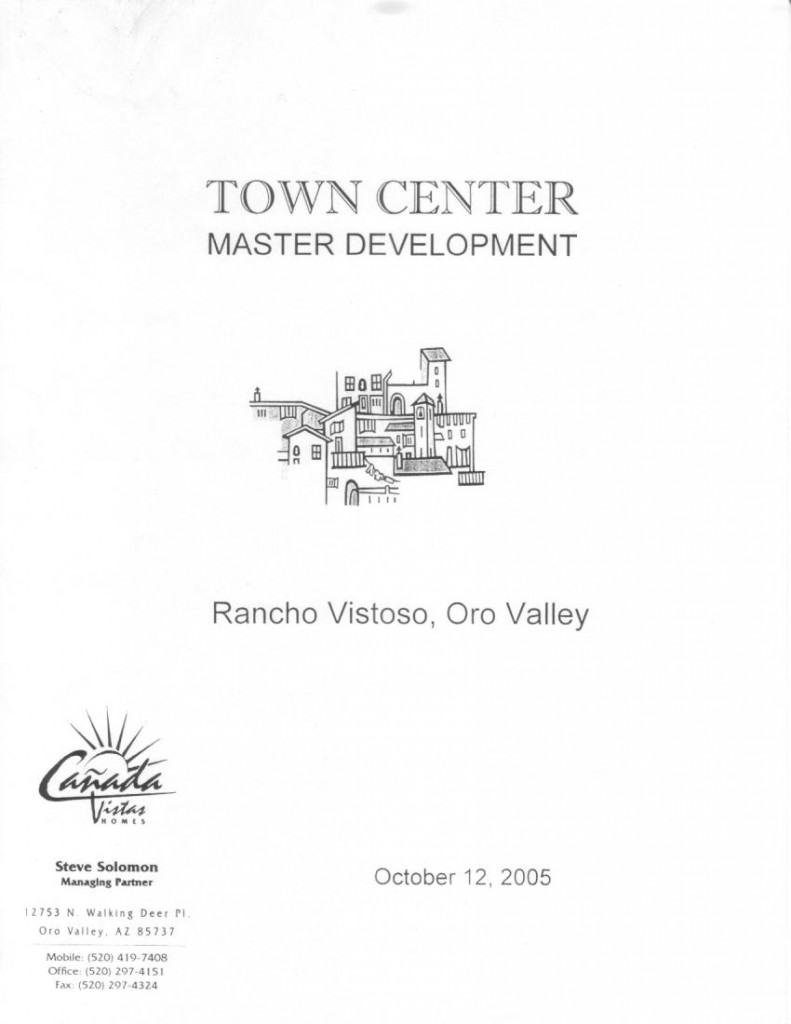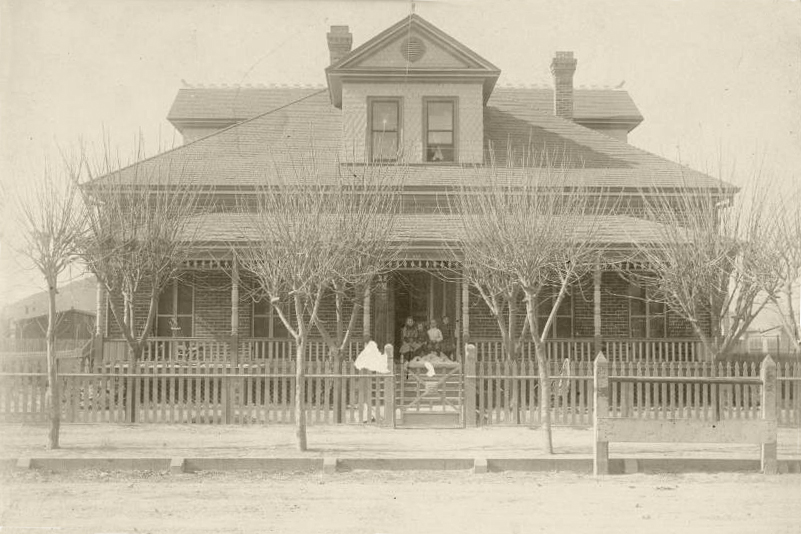



 The Town Center is an 87 acre site located at the Southeast corner of Rancho Vistoso Blvd. and Moore Rd. in Oro Valley. This site, which is privately owned, was formed as a part of the 1987 Rancho Vistoso PAD. At that time it was envisioned that this would be the center of the Town of Oro Valley, thus its name the “Town Center”. As such the Town Center was hard zoned for a wide variety of uses including very high density residential (up to 21RAC) and a mixture of commercial uses.
The Town Center is an 87 acre site located at the Southeast corner of Rancho Vistoso Blvd. and Moore Rd. in Oro Valley. This site, which is privately owned, was formed as a part of the 1987 Rancho Vistoso PAD. At that time it was envisioned that this would be the center of the Town of Oro Valley, thus its name the “Town Center”. As such the Town Center was hard zoned for a wide variety of uses including very high density residential (up to 21RAC) and a mixture of commercial uses.
Located within the boundary of the Town Center is the actual Honey Bee Village Hohokam archaeological site The Honey Bee Village site is the most significant archeological site in the Town of Oro Valley. This site, occupied from 700AD through 1200AD, includes several hundred pit houses, a walled compound and a ball court. Its preservation and study is of the utmost importance to the Town of Oro Valley, Pima County and the Indian Nations,
The development of the Town Center poses a unique challenge. On the one hand, the Town Center contains the unique and irreplaceable cultural and historical resource of the Honey Bee Village. On the other hand, the Town Center land is fully entitled for development with only the requirement to mitigate the archaeological site and then build over the site Additionally, the land value for just the core area of the Honey Bee Village (approximately 13 acres) is $8,000,000 which far exceeds the available preservation bond funds of S1,000,000.
The successful, responsible and appropriate development of the Town Center requires a new and unique approach in which all interested parties work together in partnership throughout the entire development design process. This was accomplished through the formation, by the Town of Oro Valley, of the Honey Bee Village Preserve Working Group. This working group originally tasked with only preparing a conceptual plan for the preservation and management of the Honey Bee archaeological site was expanded in both scope and participants to encompass a conceptual development plan for the entire Town Center_ The working group addressed the issues of what should be preserved, how it should be preserved and the integration of the preserve with both residential and commercial development.
The expanded working group included representatives from the Town of Oro Valley (Mayor, Town Manager, Planning & Zoning, Parks & Recreation), the Town of Oro Valley consultants (Community By Design & Desert Archaeology), Pima County (County Administrator, Cultural Resources & Historical Preservation), the Tohono O’Od ham Nation (Executive Staff, Cultural Affairs & Cultural Preservation), the Arizona State Museum and the land owner and developer, Canada Vistas Homes.
The goals of the Town Center development were:
1. Preserve the core of the Honey Bee Village
2. Create a historical focal point for the Town of Oro Valley
3. Ensure the economic viability of the Development
4. Ensure unique and compatible residential and commercial development_
As a result of extensive meetings and planning sessions a conceptual preservation plan and development plan accomplishing the above goals and agreeable to all parties has been developed. The Town Center development is focused around the formation of the “Honey Bee Village Preserve”. This preserve encompasses the vast majority of the archaeological features believed to have formed the core of the village including the ball court and walled compound, The Honey Bee Village Preserve is being created by the donation of 13 acres by the land owner and developer, Canada Vistas Homes. The Preserve will be held in the public domain and will be accessible to the public, In addition Pima County is utilizing the voter approved Honey Bee Village preservation bond funds ($1,000,000) to provide the necessary archeological studies, surveys and mitigation of the remainder of the Town Center site outside of the preserved core area
The draft Honey Bee Village Archaeological Preserve Conceptual Site Plan was accepted by the Oro Valley Town Council on July 6, 2005 and forwarded to the Tohono 010d ham Nation for their review and comments_ The Tohono O’Od ham Legislative Council approved a resolution supporting the Conceptual Plan on September 14. 2005.
In addition to the Honey Bee Village Preserve the Town Center development consists of three separate development areas:
Although the Rancho Vistoso Pad allows for high density development of the Town Center Neighborhood, the developed areas account for only 50% of the total 87 acres_ The designs of both the commercial and residential areas will be such that they reflect the Southwest native heritage of this site. All structures, walls, yards. landscaping and any other types of development will be in compliance with a set of Architectural Guidelines to ensure compatibility with the historic nature of the Town Center.
The Town Center development will truly be a one-of- a -kind unique community, not only in Oro Valley, but all of Southern Arizona, The Honey Bee Village Preserve will be the largest historical site in the Town of Oro Valley and is expected to be the jewel and focal point of the historic past and heritage of the Town_ The future residents of the Town Center community will be drawn by the archeological preserve and eager to participate in it preservation. Its historical significance along with the unique community design. open space, expansive vistas and central location will result in an unique and wonderful addition to the Oro Valley community.

PUSCH FAMILY HISTORY
by Henry Zipf
At 18 years of age, George Pusch was the older of two teenage boys who traveled to America in 1865.
George had been born in Germany on June 24, 1847 and met his friend John Zellweger there in their youth; John was four years younger than George.
The boys were probably filled with some of the same hopes and dreams that many European immigrants had during their tremendous influx into the United States and Mexico during those years.
Both George and John were bright, hard working, industrious people. They had learned the trades of farming and butchering in their native land and used those skills to provide incomes for themselves after their arrival in the United States.
They traveled from the New York area to the midwest and then on to golden San Francisco and Los Angeles all in nine year’s time.
At the age of 27 George Pusch thought that the time had come for him to be a “Py Gott, big cattleman!” So he bought a wagon and a span of 14 mules and headed for Prescott, Arizona. Then it was on to Phoenix and finally to Tucson.
It didn’t take George long to find a place to set his plan in motion. Especially after his friend John joined him in Tucson.
Together they pooled their resources again and slowly but surely saw their dreams become reality.
Pusch bought the property and cattle of the Canada del Oro Ranch (Township 12 South, Range 13 East, Section 12, 13,& 24) located north of Tucson.
Zellweger purchased a ranch on the Gila River (Township 5 South, Range 13 East, Section 4) located approximately 100 miles to
the north of the del Oro spread. The men registered the PZ brand and installed a steam pump on the well located near the Canada del Oro. The ranch became quickly known as the Steam Pump Ranch or Pusch’s Steam Pump Ranch.
The ranch became a favorite watering spot (15 cents per head) for livestock on their way to market, served as a stage stop for Wells Fargo (Tucson to Florence), and was a well-known place to camp for military patrols from various Army posts.
Pusch soon set up the Pusch Land and Cattle Company. The two men opened a butcher shop in Tucson in 1875. They owned the leading slaughterhouse and wholesale/retail meat firm in the city from 1875 until 1925.
Another 1875 venture was the Tucson Ice and Cold Storage Company which produced a total of 15 tons of ice a day in 1900 to an unbelievable 85 tons a day by 1921.
Pusch also became a minor partner in the Aravaca Land and Cattle Company (Pusch, Began & Bernard) in 1875.
A few years after Pusch had become well established in the business world he met 14-year-old Mathilda Feldman who had just arrived in 1879 from Germany.
Mathilda Feldman was born in 1865 near Drokenberg. She was a girlhood friend of Sophie Zellweger.
Pusch married Mathilda on April 24, 1880. He was 33 at the time; she was 15.
Pusch’s partner John Zellweger married in 1883 and sold out his interests in all the Tucson ventures to Pusch the same year. The Zellwegers relocated to the Florence area where they became involved in purchasing and managing extensive farming and ranching acreages.
Pusch purchased the Pleasant M. Gibson property located near
the San Pedro River in eastern Pinal County in 1886. Additional adjacent properties were accumulated in later years from Annie Gilbert (1887), as well as deeds to three Gibson Springs locations and a Mesquite Springs locale. He put Henry Feldman, Mathilda’s brother, in charge of the San Pedro Ranch operation.
The Puschs parented 9 children. Mathilda was 17 years old and the first births were a set of twin girls (Mathilda and Jenny) born March 29, 1882. The babies died about two weeks later on April 15 and 16, respectively. Then came 7 more: Gertrude (April 4, 1883); George, Jr. (March 30, 1885); Henrietta (June 17,
1883); Wilhelmina May 20, 1890); Mabel (November 28, 1391); Fritz (Fred) (September 28, 1894); and Walter (January 5, 1898).
Pusch’s business enterprises had grown to the point that he had to move his Mesilla Meat market to 34 Congress. He also bought the 26, 30, 34, and 36 East Congress Street properties. It had formerly been owned by Chris Christensen who had his corrals and livery barn at that locale.
The Pusch family as well as the Zellwegers were charter members of the Congregational Church in Tucson.
Pusch was also a director of an early Arizona bank. He served on the Tucson City Council, and as a Republican member Pusch represented Pima County in the Sixteenth and Twentieth Territorial Legislatures. In 1910 he was a member of the Constitutional Convention.
In addition, George Pusch was Chairman of the Territorial Livestock Sanitary Board for 4 years.
Shortly after his involvement with the convention activities and Arizona’s admission to the Union, George began experiencing some significant medical problems. Plagued by several strokes for ten years, he died August 20, 1921 at the age of 74. He was at his home at 428 South Fourth Avenue in Tucson when he passed away.
George Pusch, Jr. took over operation of the Steam Pump Ranch in August of 1921. On June 27, 1928 George sold Pusch Land and Cattle Company, the East Congress Street lots ($70,000). In 1933 J.M. (Jack) Proctor, owner of the Pioneer Hotel in Tucson and Director of the Valley National Bank, bought the Steam Pump Ranch from Mathilda’s estate for $10,000.
Proctor’s daughter Elizabeth (Betty) married Henry Lieber. Some of the original Steam Pump Ran property is still currently under the ownership of the Lieber family.
On November 24, 1933 the Steam Pump Ranch was raided and a liquor distilling plant was uncovered. The ranch had become a home
for an 80-gallon still. Arrested and charged with IRS tax violations was John J. Hartney.
Mathilda Feldman Pusch died June 30, 1938 at 428 South Fourth Avenue in Tucson. She was 73 years old.
George W. Pusch, Jr. died at the Canada del Oro Ranch just south of the Steam Pump Ranch on August 31, 1957. He was 72. A brother Fred Lewis Pusch died at the age of 64 on October 29, 1958.